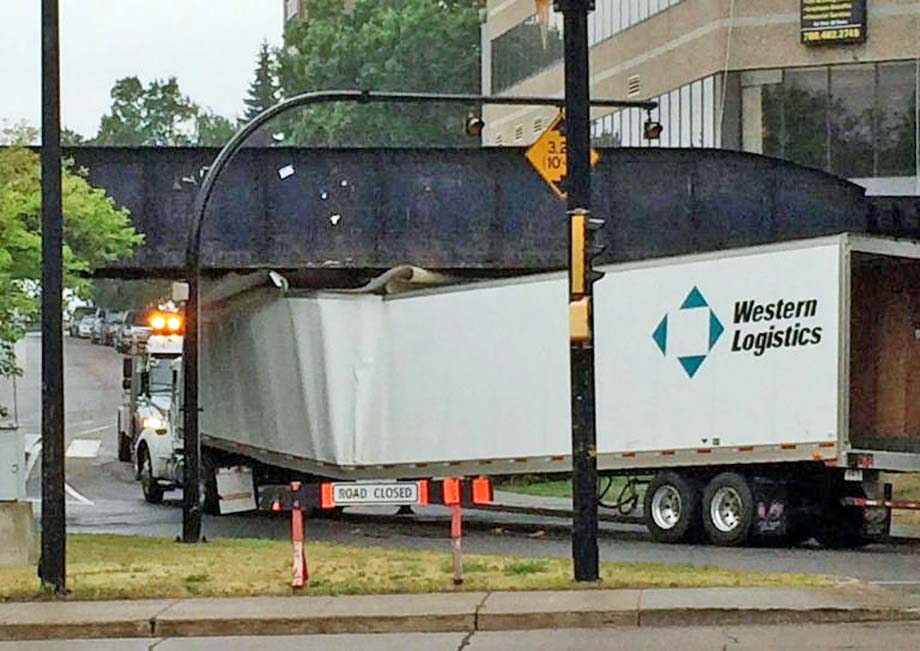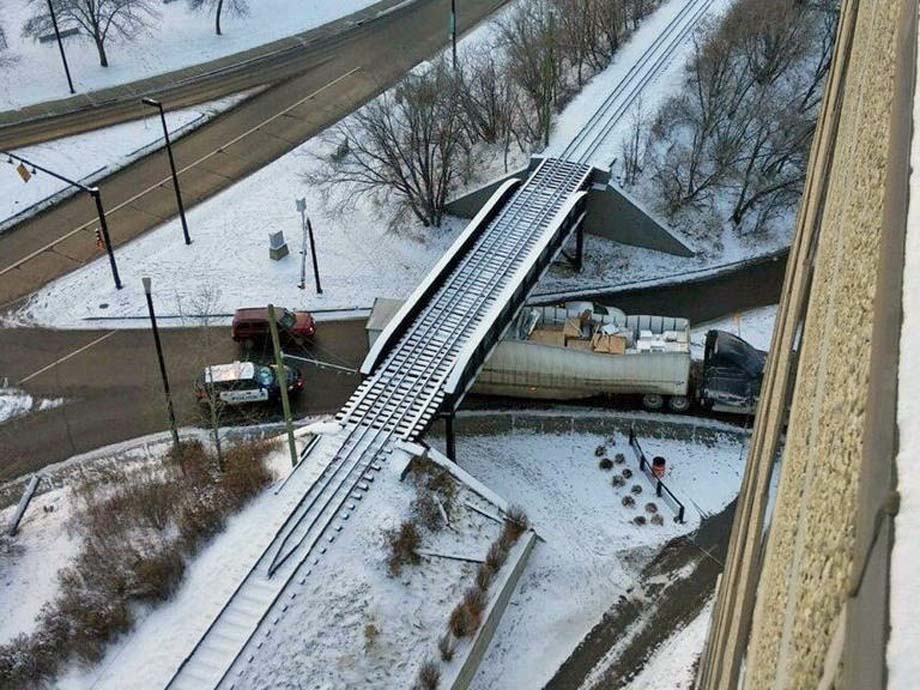
Edmonton Alberta - It's one of the most Edmonton things you can see, a large transport truck
locking horns with the too-tight-for-their-load High Level Bridge.
Despite regulations and warning signs upon the one-way entry from two streets to the 1913 bridge, some out-of-town
truckers continue to get jammed by its low clearance of 3.2 metres (10 feet 6 inches) and narrow one-way, two-lane,
width.
A recent example was 17 Nov 2023 when Postmedia photojournalist Greg Southam happened to be under the High Level
shooting pictures when he heard a big "kaboom" and emerged from his vantage point to see a large truck stuck
in the mouth of the bridge.

"There was a huge traffic jam after that," he said, adding he did not stick around to see it
extracted.
Most trucks that get stuck have help from first responders to back their units up and get out onto open road, routinely
causing major traffic backups on one of the few southbound routes out of the core.
Edmonton city police say records show there were six collisions that involved a truck striking the High Level Bridge
in 2023, noting that not all of them got stuck.
All that said, why is the High Level such a peril for some truck drivers?
What About the Signage?
There are two signs prohibiting truck drivers from entering the bridge, and professional commercial drivers should be
able to see them, said Sasha Boskovic, sales and logistics manager with Grimshaw Trucking LP, in a recent interview
with Postmedia.
"I don't think there's anything structurally wrong with the way it was positioned because there's a sign that goes
from the 96th Avenue and then there's a sign that goes from 109 Street that says it's a non-truck route," said
Boskovic.
There's ample time to follow the signage so "there's no reason for trucks to keep getting stuck," added Roger
Little, senior driver instructor at Gennaro Transport Training, in another interview.
Boskovic suggests that drivers who go under the bridge are "not reading the signs properly."
"We are in the business of transporting goods, and we need to do it in a safe manner for the operator, for the
public, and for the environment," Boskovic added.
Are Truck Drivers Getting Enough Training from Driving Schools?
Under provincial regulations there is mandatory entry-level training consisting of 40 hours of classroom instruction
that truck drivers have to go through, where they learn that they should not go under bridges with less than 4.15
metres' clearance.
"We talk about the width and the length of the trucks, and the heights of an average truck, and about watching
signage while driving down the road," Little said.
The bridge has been hit multiple times by experienced and inexperienced drivers, not because of inappropriate training,
but because of delivery pressure from dispatchers, distracted driving, or negligence, said Little.
Hands-on experience is as important as training at schools, according to Little.
"They're going to get more experience while they're driving with the companies, and that's where companies need to
have their trainers or other drivers within their company to help these people to get started," he
said.
Coming from a different city isn't a good excuse to hit the bridge, added Little, noting that there are different apps
and map books for truck roads.
Before they're qualified to hit the road, truck drivers have to do a road test with strict rules.
"The road test is the same road test as it is with cars. Other than with cars, they're allowed 75 points. A truck
is only 50 points. They are marked hard if they're grinding gears at all, or they failed to use your second lights, or
if they rub a curb or touch a curb, that's automatically failures on the road test," Little said.
What Happens to the Structure of the Bridge and the Trucks After Getting Struck?
"The road approach angle and low traffic speed" protect the structural integrity of the High Level Bridge
when truck drivers go underneath, Caitlin Zerebeski, director of infrastructure maintenance at the City of Edmonton,
told Postmedia in an email.
However, the biggest impact would be on traffic, especially when a tow truck is needed to help the stuck truck back
out, added Zerebeski.
"Over the last three years, there have been no records of repair on the High Level Bridge due to high load
damage. In most cases, the low clearance bars ahead of the bridge approach need to be reset, where the cost of this
work is nominal," said Zerebeski.
While the bridge didn't suffer substantial damage on 17 Nov 2023, Southam says the top part of the truck was severely
damaged.
What Are the Consequences?
Speaking of the consequences of going under the bridge, drivers can lose their licence, depending on investigation
results, and sometimes their jobs, while companies incur an increase in insurance rates, according to
Little.
"If you have a lot of trucks that are not following the rules and regulations, that goes against the carrier
profile, which will cost the company their licence to be able to operate," Little added.
City buses, at 3.1 metres tall, fit on the bridge with 10 centimetres to spare.
Most fire trucks also fit, though not the larger ladder trucks, according to emergency officials.
The historic bridge is located next to the Alberta Legislature Building and originally linked the communities of
Edmonton and Strathcona, which became one city in 1912.
It was designed from the outset to accommodate rail, streetcar, two-way automobile, and pedestrian
traffic.
Currently, street traffic is one-way southbound.
At the north end of the bridge, 109 Street enters into the left lane, and 110 Street enters into the right
lane.
Toula Mazloum.
 I'm not sure who reached the Edmonton area first, the early
railway taken over by CP or CNoR? I suspect it would be the railway coming north from Calgary that reached
Strathcona first. Eventually the High Level Bridge was completed which permitted CP to reach their station on
the north side of the river. That station was demolished sometime in the 1970s or 1980s.
I'm not sure who reached the Edmonton area first, the early
railway taken over by CP or CNoR? I suspect it would be the railway coming north from Calgary that reached
Strathcona first. Eventually the High Level Bridge was completed which permitted CP to reach their station on
the north side of the river. That station was demolished sometime in the 1970s or 1980s.
(likely no image with original article)
(usually because it's been seen before)
provisions in Section 29 of the Canadian
Copyright Modernization Act.
